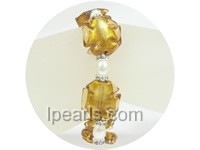Very small mantle tissue beads

Very small mantle tissue beads are implanted inside the Pinctada fucata martensii oysters to form beautiful akoya pearls. Akoya oyster rarely produces more than two pearls whereas freshwater oysters are nucleated to produce about fifty pearls each. Akoya pearls normally take longer time to grow and the total quantity comparatively is not very large due to variable seawater climatic conditions and oysters’ mortality.
The Ancient Greeks were aficionados of jewelry, wearing simple to complex jewelry often complemented with effigies of the Greek Gods Eros, Nike, Artemis, Isis and Aphrodite. Mycenae, the ancient Grecian city ruled by King Agamemnon, was the center for jewelry production in the 2nd millennium B.C. The Mycenaeans created jewelry of beads in the shape of animals and shells, gold, amethyst, emeralds, pearls, agate and other semi-precious stones in the evolution of their jewelry production from 1,400 BC- 300 BC.
The Greeks created the cameo, produced by using an agate stone striated with pink, cream or brown also called Indian Sardonyx. As jewelry design and techniques became more complex, they developed a laurel wreath to be worn as a crown of honor by scholars and heroes, sacred laurel leaves represented Apollo, the god of prophecy and intellect. Pendant earrings bedecked with Nike, Eros or dove figurines became popular fashion of the times. Pendants in the shape of Amphorae (the classic two-handled vase shape) ornamented with enamel or gemstones, hung by a rosette and capped with the crown of Isis. Spherical or wide chains of gold were worn as necklaces with hanging calyxes or fruit and clasps of animal heads or dolphins. The Greeks were fond of wearing gold wreaths as ornamental headdresses, elaborately decorated with flowers, acorns, foliage or images of Eros and Nike. Greek gold rings were set with gemstones or sealstones (containing an engraving used for seals).
After the fall of Greece by Alexander the Great’s viscious conquest, the Hellenistic age begins, dating 330-27BC. Jewelry of this time was influenced by the Far East and Egypt, initiating new fashions, tastes and styles not only in jewelry design but overall aesthetics of life. Gold became the dominating metal accompanied by gemstones such as amethyst, cornelian, garnet, rock crystal and chalcedony during Hellenic rule.
Etruscan jewelry, highly influenced by Greek culture, produced a large amount of intricate and ornate jewelry styles that further influenced the Romans. The Etruscans developed granulation (where the surface of gold was soldered with tiny grains of gold to create a delicate pattern) dated to the 7th century BC. By the end of the Etruscan Period, as they were absorbed by the Roman Empire in the 3rd century BC, the ornate designs were replaced by more austere qualities and filigree (fine wire work with silver or gold) was utilized. The Phoenicians contributed colorful beads, inlay and enameling. Rings of this period included a scarab or single set gemstones in an oval formation set in an engraved bezel.
Are you interested in pearls? Epecialized in wholesale cultured pearls jewelry imported from all over the world. Once one understands the variety of wholesale pearl strands, cheap pearl necklace, freshwater pearl bracelet, pearl rings, pearl earrings, cheap pearl pendant, 925 sterling silver jewelry, cultured pearl beads … available (the different shapes, sizes, colors and qualities of pearl beads) then one can identify or compose the single strand necklace that is appropriate. You can check out a good website which I saw suddenly. You can check pearl necklace page for more information. This will explain about the quality of all the different types of pearls. Enjoy yourself.
pearl jewlery wholesale, wholesale pearl jewelry, wholesale pearlsTags: diamond engagement rings, fashion jewelry, men and women, vein of love, wholesale sterling silver jewelry
